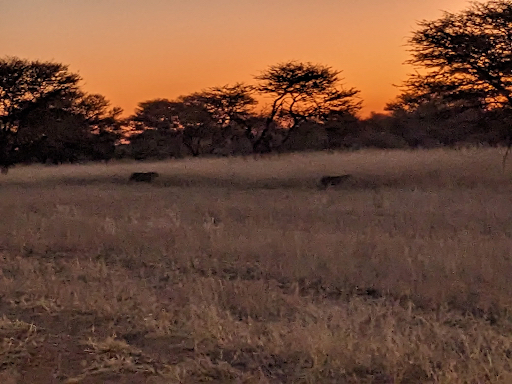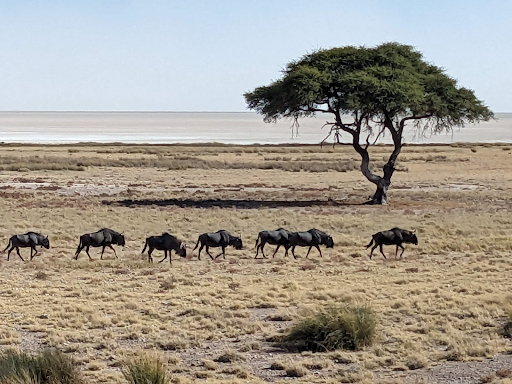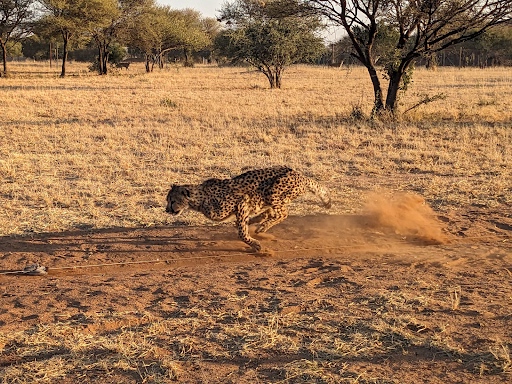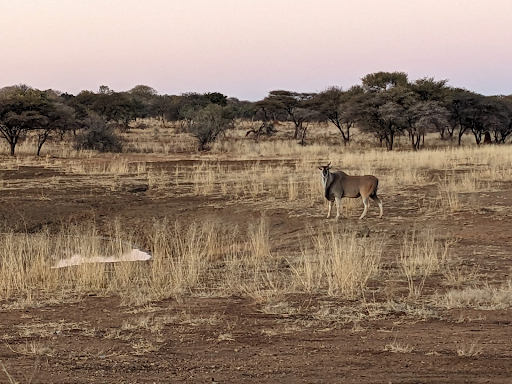Student Reflection
Namibia Student Reflection: Kate Hankins
 Darkness.
Darkness.
Starlight.
Flashlight.
Eyeshine.
Fright.
Relief.
Duiker.
A Toilet Trek Word Poem
 One of the overall experiences in Namibia for me was challenging assumptions. I’d read so many books and seen so many movies and documentaries about Africa and the animals and people who live there. The reality was similar in some ways but mostly very different from what I expected. It’s hard to really describe what my preconceived ideas were versus what we experienced, but I now have real images in my head when I think of Africa instead of pictures from books or TV. I also have real emotions attached to those images, whether the thrill of seeing two shadowy leopards running away from our safari vehicle, the dread of leaving a warm sleeping bag and trekking across the camp to the bathrooms in the middle of the night, or the joy of joining a group of friends by the warm fire in the evenings after a long day of learning and discovery. My thoughts of Africa will never be the same again, and I look forward to continuing to challenge other assumptions in the future.
One of the overall experiences in Namibia for me was challenging assumptions. I’d read so many books and seen so many movies and documentaries about Africa and the animals and people who live there. The reality was similar in some ways but mostly very different from what I expected. It’s hard to really describe what my preconceived ideas were versus what we experienced, but I now have real images in my head when I think of Africa instead of pictures from books or TV. I also have real emotions attached to those images, whether the thrill of seeing two shadowy leopards running away from our safari vehicle, the dread of leaving a warm sleeping bag and trekking across the camp to the bathrooms in the middle of the night, or the joy of joining a group of friends by the warm fire in the evenings after a long day of learning and discovery. My thoughts of Africa will never be the same again, and I look forward to continuing to challenge other assumptions in the future.
 The Cheetah Conservation Fund was, of course, a highlight of the trip. I never realized the extent of what they do, both locally and globally. It’s incredible to see the lengths that people can and will go to to save wildlife. The variety of enterprises they’ve started in the community is awe-inspiring, and they just continue trying new things and working to make a difference no matter the odds. It was especially amazing to see the livestock guarding dogs and scat detection dogs in action (Marker and Boast, 2015). I’d heard of livestock guarding dogs before but had never met one or learned the specifics of how they protected livestock. Scat-detection dogs were new to me, and since our travels, I’ve seen other studies about their use in predator conservation. The genetics lab, creamery, daily cheetah feedings and educational talks, museum, and demonstration farm are all different tools used to accomplish CCF’s mission of conserving cheetahs in their wild habitats and teaching the community how to coexist with them. The organization’s perseverance and flexibility are impressive and inspiring!
The Cheetah Conservation Fund was, of course, a highlight of the trip. I never realized the extent of what they do, both locally and globally. It’s incredible to see the lengths that people can and will go to to save wildlife. The variety of enterprises they’ve started in the community is awe-inspiring, and they just continue trying new things and working to make a difference no matter the odds. It was especially amazing to see the livestock guarding dogs and scat detection dogs in action (Marker and Boast, 2015). I’d heard of livestock guarding dogs before but had never met one or learned the specifics of how they protected livestock. Scat-detection dogs were new to me, and since our travels, I’ve seen other studies about their use in predator conservation. The genetics lab, creamery, daily cheetah feedings and educational talks, museum, and demonstration farm are all different tools used to accomplish CCF’s mission of conserving cheetahs in their wild habitats and teaching the community how to coexist with them. The organization’s perseverance and flexibility are impressive and inspiring!  The people we met in Namibia struck a chord in me, especially Iggy and Johann. Hearing Johann speak from the perspective of the farmers and the struggles they face made it hard to keep breathing much less think straight. Then, after spending the week with us and allowing us to constantly plague him with questions, Iggy spoke about his efforts to improve the lives of his community. So often, conservation efforts lose sight of the people who bear the costs of those efforts and one way this program excels is in pulling them back into the forefront of our consciousness and giving us opportunities to speak to and learn from them (Western et al., 1994a). Conserving animals can only happen with and for the local people, and we will always be stronger for including them.
The people we met in Namibia struck a chord in me, especially Iggy and Johann. Hearing Johann speak from the perspective of the farmers and the struggles they face made it hard to keep breathing much less think straight. Then, after spending the week with us and allowing us to constantly plague him with questions, Iggy spoke about his efforts to improve the lives of his community. So often, conservation efforts lose sight of the people who bear the costs of those efforts and one way this program excels is in pulling them back into the forefront of our consciousness and giving us opportunities to speak to and learn from them (Western et al., 1994a). Conserving animals can only happen with and for the local people, and we will always be stronger for including them.
The experience that most sticks out in my brain for being both terrifying and breathtaking was the 12-hour waterhole count. Being dropped off in darkness in an unfamiliar place in the middle of nowhere was definitely outside of my comfort zone. I remember huddling in my sleeping bag in the tiny hide with Charlotte, trying to breathe, and wondering if a leopard or baboon was sneaking up behind our very pregnable shelter. The relief I felt as the sun finally rose and showed us the picturesque waterhole we’d be watching for the day was immense. Then, hearing hoof clops on the rocks behind us and getting our first wildlife visit from a huge eland made the long wait for dawn worth it. The sightings occurred slowly for many hours but each visitor made my heart jump as we got to see firsthand what the animals of the Waterberg Conservancy did during the day after a new moon. It brought the realities of conservancy life into focus as we watched kudu and oryx drink and play while listening to the sound of farmers working nearby. My favorite visitors were the ridiculous warthogs who’d run into view, drink for a bit, and then scamper around playing with one another before running away from some other arriving visitors with their tails held high.
 Africa is one of those places I’ve always wanted to visit but always felt so far away to be possible. The worst part of the trip for me was what I’d expected it would be, the flights there and back, especially the flight back home since I no longer had the anticipation of a grand adventure to keep me going. My ability to keep moving and maintain focus even when confused or frustrated allowed me to make it home despite some annoying delays and customs hold-ups. When I finally got home I was drained and spent the next few weeks trying to recover from pouring so much energy and emotion into the experience. It was hard returning to my normal life, both feeling changed and feeling like I’d never left. Now that I’ve recovered and found my stride at home again, I’m able to bring what I experienced and learned in Africa into my work, my life, and my education as I continue to grow and learn more about conservation worldwide. Africa feels closer now, and though I’m still not excited about those 20+ hours on airplanes to get there, I’m excited to return to continue exploring and inquiring.
Africa is one of those places I’ve always wanted to visit but always felt so far away to be possible. The worst part of the trip for me was what I’d expected it would be, the flights there and back, especially the flight back home since I no longer had the anticipation of a grand adventure to keep me going. My ability to keep moving and maintain focus even when confused or frustrated allowed me to make it home despite some annoying delays and customs hold-ups. When I finally got home I was drained and spent the next few weeks trying to recover from pouring so much energy and emotion into the experience. It was hard returning to my normal life, both feeling changed and feeling like I’d never left. Now that I’ve recovered and found my stride at home again, I’m able to bring what I experienced and learned in Africa into my work, my life, and my education as I continue to grow and learn more about conservation worldwide. Africa feels closer now, and though I’m still not excited about those 20+ hours on airplanes to get there, I’m excited to return to continue exploring and inquiring.